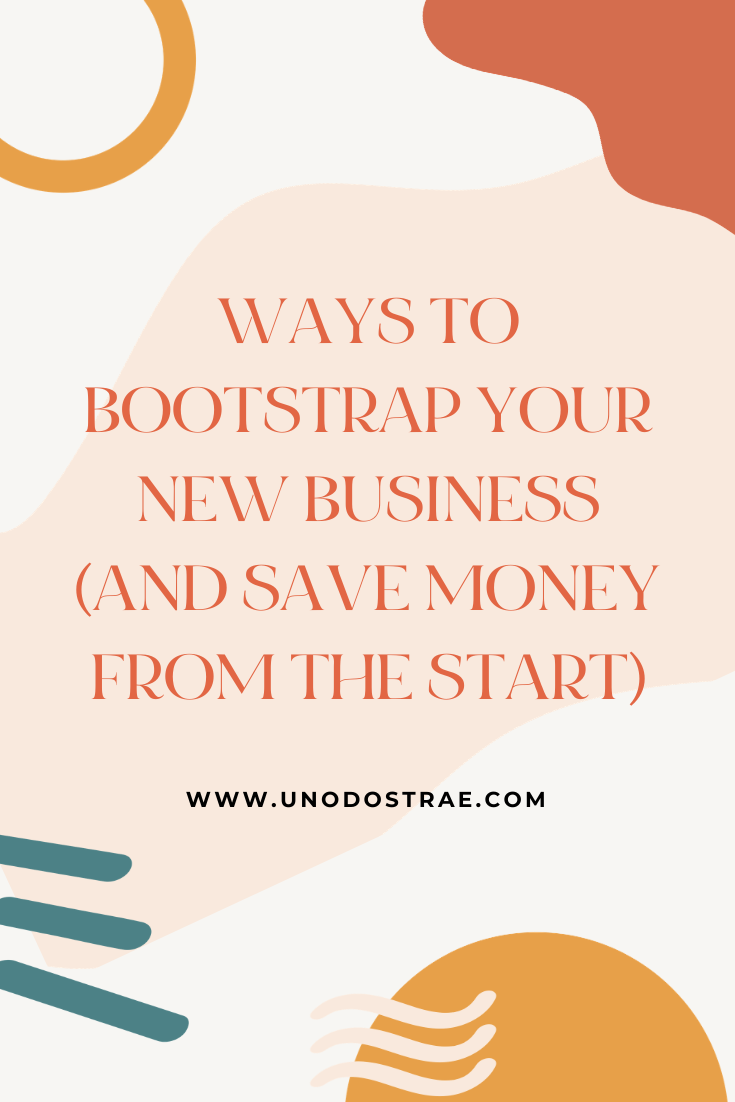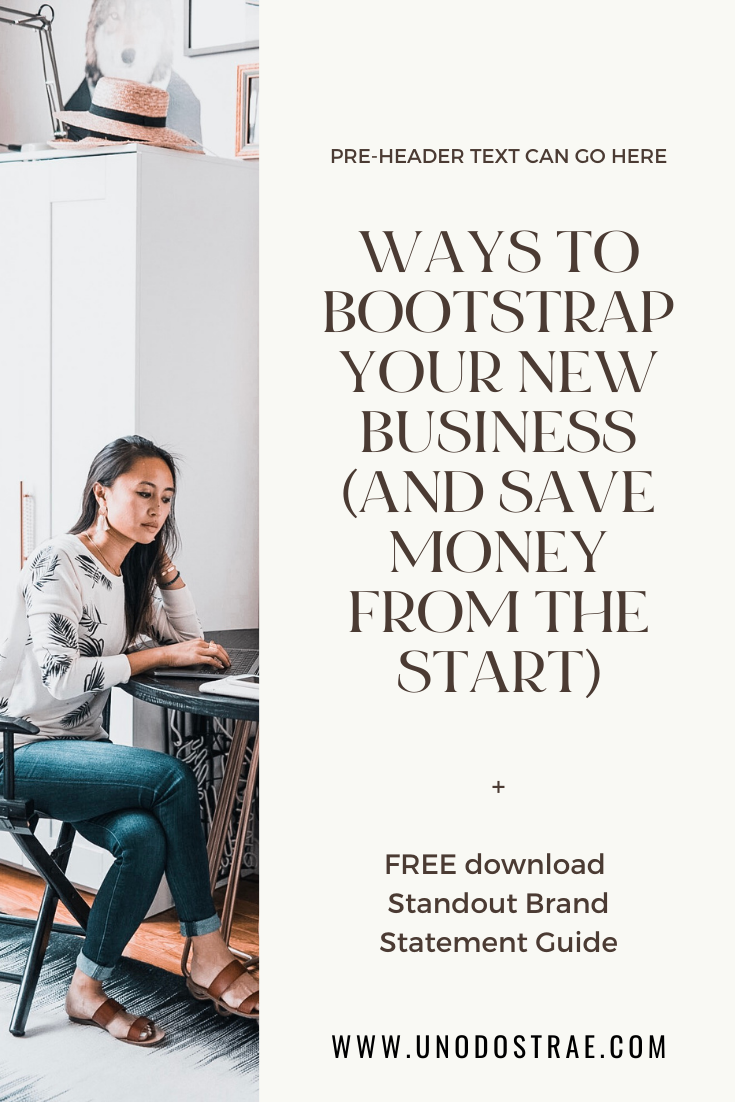
If you find yourself reading about entrepreneurship pretty often, you’ve definitely heard the term bootstrapping your business. Bootstrapping, which quite literally hints to pulling yourself up by the bootstraps, is a way of building a business without outside investment or large financial help. In other words you are, in large part, self-funded. And for plenty of people—especially when it comes to small, creative businesses—bootstrapping is the only option. Over here, I’m all about getting a little scrappy and innovative when it comes to making things work, and I’d like to bet that you are, too.
When I started Uno Dos Trae, I didn’t have an angel investor or Mark Cuban from Shark Tank on my side (though that would have been nice). It was me, myself, my savings, and a lot of hard work. The concept of bootstrapping your business was my mentality from the beginning, and in learning how to do many things for my business myself, I’ve been able to create a solid foundation of entrepreneurial skills, business acumen, and marketing know-how because of it. If you’re thinking of starting a business (or you’ve already started one), and are looking for smart ways to bootstrap, here are the 3 strongest ways you can start:
-
Validate your idea
If you’re a DIY entrepreneur and are bootstrapping your business (even if it’s just parts of it), validating your idea can save you from a lot of wasted effort and from making a ton of expensive mistakes that you could have otherwise avoided.
Idea validation is simply the process of testing your idea first prior to doing any of the work to launch it. This is like the research and development phase that big companies use to test product ideas before they’re released to the general public.
What does validating an idea entail? Talking your ideal customer or ideal community—the exact person or people who you will be serving with your new idea. You want to launch something that they’ll easily get on board with and eventually buy from or book with you, right? So what do they need this idea of yours to look like? If it’s a product or service, what features and format will you deliver your offering in? Have they ever purchased something similar before? How did it work out for them?
If you already have an audience that you are creating your new offering for, you can create a quick survey in Google Forms or Typeform to send to your mailing list, conduct a poll on Instagram stories, or talk about your idea in an Instagram post and ask your followers to help you out by leaving a comment. If you don’t have an audience yet, determine where your ideal customer hangs out and be proactive in engaging with them. You only need a few people who fall in your demographic to interview or chat with in order to gain valuable insight in validating your idea. Facebook groups are a goldmine for this as is the hashtag search feature in Instagram to find relevant accounts that you can send a DM to.
The information and insight you collect when validating your idea first can be crucial in predicting your idea’s success as a real thing and seeing if it’ll actually take off. It will also tell you if you can make a viable income from this idea, if it’s sustainable, and will allow you to eventually scale into something bigger.
And this applies to anything you cook up: new company, product idea, an online course you want to launch, signature coaching program. Sometimes what we think people need isn’t actually the case. So it’s always prudent to first check.
-
Utilize your skills
If you’re reading this, I know you have a little scrappiness in you. Every business owner, no matter what your story or journey has looked like so far, has to have some moxie and drive—and that’s what makes this lifestyle so dang special. But, that scrappiness shows up really big in one way at the beginning of entrepreneurship: and that’s how many hats you’ll probably find yourself wearing. Whether it’s getting really, really good at Quickbooks (it’s easier than you think, I promise!) or finally figuring out how to optimize your workflows without the help of a VA, the best way to bootstrap your business is by really utilizing your own skills.
In fact, utilizing your own skills is quite literally what makes the bootstrapping world go round. After all, if you don’t have the funds to justify outsourcing work to someone else, then it’s up to you to make things happen. And you don’t necessarily have to start from scratch, either. There are plenty of templates and tools you can take advantage of that will help elevate your brand’s perceived value and messaging:
- If hiring a web designer isn’t in the budget right now, purchase a solid pre-made website template for a fraction of the cost.
- If you’re not able to outsource to a copywriter, invest in swipe files and copywriting templates to help you create your email sequences, sales page copy, and Instagram captions.
- If you can’t justify hiring a graphic designer, utilize free template designs on Canva or purchase professionally designed templates that really elevate your branding and perceived value.
Doing things yourself not only expands your own personal skillset but it also keeps your overhead expenses low. Whether you’re great at taking pictures or you remember how to use Photoshop from that one graphic design course in college, take advantage of you. Keeping overhead low will give yourself more opportunity on this journey, whether that opportunity lies in giving yourself more capital or having the capacity to work with other businesses to trade or barter services that help you both.
-
Invest time and money
While bootstrapping your business will certainly help you save a ton of money, you can’t be afraid to eventually invest in your business, either. Sometimes you have to spend money to make money. Over my years in business, I’ve learned that the only kind of shortcut that truly exists in the entrepreneurial world is learning from others. Sure, there’s a massive amount of free resources and information on the internet, but not all of it is correct. And piecing together each and every strategy yourself is undoubtedly taking the long way to achieving your goals. Not to mention, it also makes for a lonely journey.
I’ve personally invested in my business in the form of online courses and joining a mastermind. And these have been absolutely invaluable to the personal and business growth I’ve experienced thus far. For you, it could mean hiring a coach or joining a group coaching program in order to reach that next level.
Either way, it’s helpful to remember that to invest in your business is to also invest in your own personal development. To stop learning is to stop growing and as humans, we all have an upper limit that we’re meant to bust through. Plus, there’s no better way to improve your own skills than by looking towards others.
All in all, there’s nothing wilder, more stressful, or more rewarding than the entrepreneurial journey. I’ve had long months, scary times, and lots of overwhelm—but I’ve also felt the strongest pride, the biggest joy, and the most fulfillment from building a career on my own terms; one that serves others and allows me to design the kind of life I want to live.
Even with an amazing team helping me run Uno Dos Trae, there are still parts of the business that I prefer to have ownership over simply because I love it. And bootstrapping in those early days is what led to me discovering that, giving me an incredible amount of space to grow and scale.
I challenge you to make it your goal to discover what exactly makes your brand and business unique, and leverage that to grow. You can start with my Standout Brand Statement Guide, and build the messaging you’ve been looking for.











